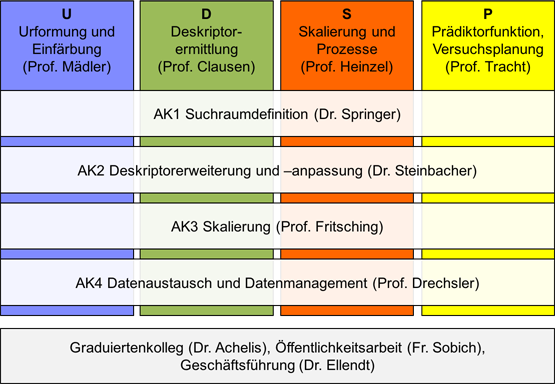About us
The initiative „Farbige Zustände" aims at the development of a novel experimental method for the development of metallic structural materials. The overall aim is the efficient and focused identification of compositions and process chains which result in a specific performance profile of the material. Conventional materials developments are based on costly experimental investigations of chemical, mechanical or technological material properties. Such expensive requirements reduce the number of possible experiments, so that mostly predictive (or intuitive) approaches are employed. As a result, potentials of non-intuitive parameter choices are not taken in account.
Combining new processes for primary shaping, micro structure formation (“coloration”) and characterization of microscopic material samples, sample logistics as well as mathematical and computer science based methods for the analyses of large amounts of data, this research initiative develops of a novel high throughput method. This methods helps to overcome resource limitations to open new frontiers for experimental materials development. The transformation of determined descriptors towards macroscopic material properties of the performance profile is achieved by a heuristic predictor function, which needs only few macroscopic samples. Compared to methods available today, the planned high throughput method features a strongly increased efficiency. The identification of novel structural materials is based on mathematics and computational sciences in order to efficiently locate promising compositions as well as process chains in a multidimensional search domain. Furthermore, the generated large amounts of data and the sample throughputs require dynamic logistics for data and samples and an their efficient handling. The method „Colored States“ allows a paradigm shift in the development of structural materials towards a resource efficient high throughput method. It allows the experimental exploration of entirely novel material groups and can be considered a valuable tool to enable innovative technologies in the future.
Working methods and structure of the Collaborative Research Center
Project Areas and Working Groups
The CRC is divided into four project areas which comply with the process chain of the method “Farbige Zustände”: In project area U micro samples are synthesized and treated. Project area D covers all required descriptors. In project area S macroscopic analyses and modelling of scaling takes places and project area P develops the predictor function, as well as a search algorithm and the design of experiments, which includes the planning of the samples and their transport.

![[Translate to English:] Zur Startseite des SFB Farbige Zustände](/fileadmin/user_upload/sites/sfb1232/Logos_und_Bilder/SFB1232-quer.png)
